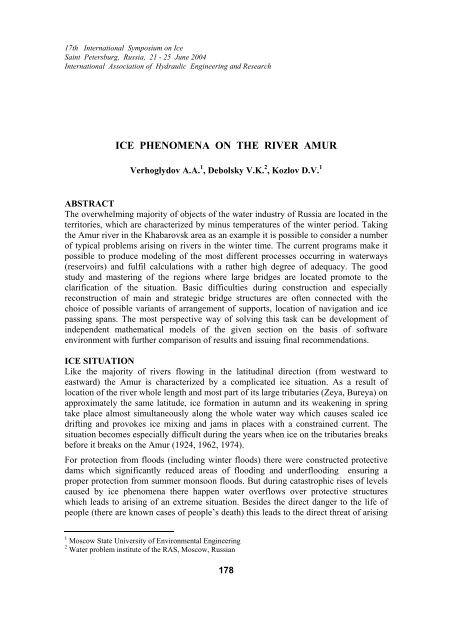Create successful ePaper yourself
Turn your PDF publications into a flip-book with our unique Google optimized e-Paper software.
17th International Symposium on Ice<br />
Saint Petersburg, Russia, 21 - 25 June 2004<br />
International Association of Hydraulic Engineering and Research<br />
ICE PHENOMENA ON THE RIVER AMUR<br />
Verhoglydov A.A. 1 , Debolsky V.K. 2 , Kozlov D.V. 1<br />
ABSTRACT<br />
The overwhelming majority of objects of the water industry of Russia are located in the<br />
territories, which are characterized by minus temperatures of the winter period. Taking<br />
the Amur river in the Khabarovsk area as an example it is possible to consider a number<br />
of typical problems arising on rivers in the winter time. The current programs make it<br />
possible to produce modeling of the most different processes occurring in waterways<br />
(reservoirs) and fulfil calculations with a rather high degree of adequacy. The good<br />
study and mastering of the regions where large bridges are located promote to the<br />
clarification of the situation. Basic difficulties during construction and especially<br />
reconstruction of main and strategic bridge structures are often connected with the<br />
choice of possible variants of arrangement of supports, location of navigation and ice<br />
passing spans. The most perspective way of solving this task can be development of<br />
independent mathematical models of the given section on the basis of software<br />
environment with further comparison of results and issuing final recommendations.<br />
ICE SITUATION<br />
Like the majority of rivers flowing in the latitudinal direction (from westward to<br />
eastward) the Amur is characterized by a complicated ice situation. As a result of<br />
location of the river whole length and most part of its large tributaries (Zeya, Bureya) on<br />
approximately the same latitude, ice formation in autumn and its weakening in spring<br />
take place almost simultaneously along the whole water way which causes scaled ice<br />
drifting and provokes ice mixing and jams in places with a constrained current. The<br />
situation becomes especially difficult during the years when ice on the tributaries breaks<br />
before it breaks on the Amur (1924, 1962, 1974).<br />
For protection from floods (including winter floods) there were constructed protective<br />
dams which significantly reduced areas of flooding and underflooding ensuring a<br />
proper protection from summer monsoon floods. But during catastrophic rises of levels<br />
caused by ice phenomena there happen water overflows over protective structures<br />
which leads to arising of an extreme situation. Besides the direct danger to the life of<br />
people (there are known cases of people’s death) this leads to the direct threat of arising<br />
1 Moscow State <strong>University</strong> of Environmental Engineering<br />
2 Water problem institute of the RAS, Moscow, Russian<br />
178

















